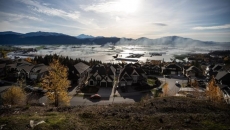A cool and wet spring in parts of British Columbia has helped suppress fire activity, but an expected turn in the weather will likely renew wildfire risk this summer.
BC Wildfire Service lead forecaster Matt MacDonald says blazes across the province have burned about 300,000 hectares so far this year.
We are currently responding to multiple incidents within Kalamalka Lake Park. BC Wildfire Service ground resources are responding along with the Coldstream Fire Department. pic.twitter.com/0BXvGwIHI2
— BC Wildfire Service (@BCGovFireInfo) June 12, 2024
MacDonald says while the amount is "not insignificant," the majority of those fires were in the northeast, and the province had logged close to one million hectares burned during the same time last year.
He says temperatures were near normal in May for much of the province, helping to slow snow melt and suppressing holdover fires from re-emerging after smouldering over the winter.
But forecasts call for warmer than normal temperatures across much of Interior B.C. in late June into July, and MacDonald says the province is "quite likely" to see large wildfires re-emerge as the summer approaches.
The continued drought, a low winter snowpack and the early wildfire evacuation of 4,700 people from Fort Nelson originally prompted officials to warn of another devastating fire season after last year's record burn.
"Given those ... conditions, it's quite likely that we will in fact see large fires in much of the province, but particularly that northeast down through the central Interior," MacDonald says. "So, please remain prepared. Continue to be vigilant."
The province has also introduced several new measures to help wildfire evacuees cope with leaving their homes this summer.
Minister of Emergency Management Bowinn Ma says they include an option for evacuees to receive a $200 daily accommodation allowance through an e-transfer, giving people more flexibility on where to stay if they have been forced out.
The Canadian Interagency Forest Fire Centre says this year's wildfire season has been less dire so far than 2023, but the expected hot weather means conditions are ripe for an above average fire season across most of Canada.
The forecast says the risk of fires in June is extreme or very high in southern and northeastern B.C., northern Alberta, southern Saskatchewan and a small pocket of northern Manitoba, as well as most of Northwest Territories.
As of this week, more than 1,480 fires have burned about 5,200 square kilometres across the country, with almost two-thirds of the burned area located in British Columbia.






